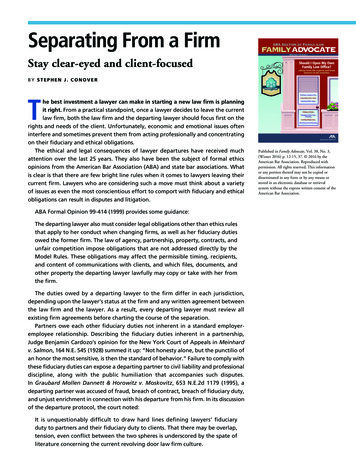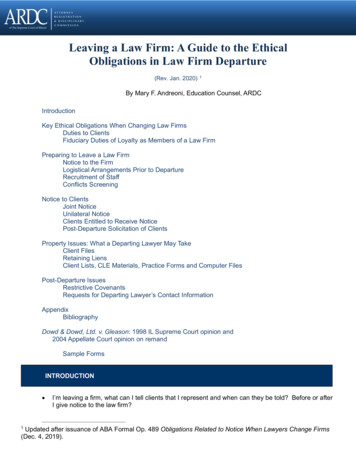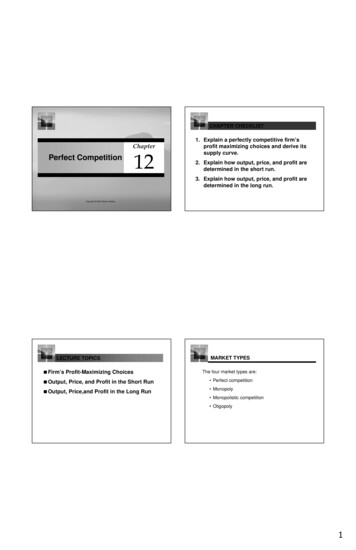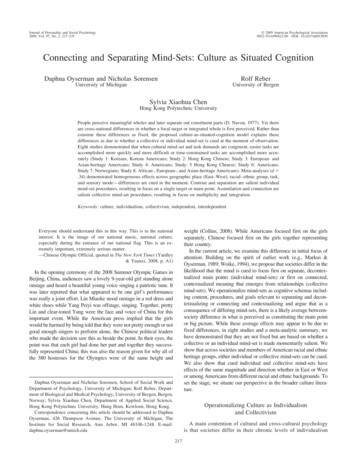
Transcription
Separating From a FirmStay clear-eyed and client-focusedBY STEPHEN J. CONOVERThe best investment a lawyer can make in starting a new law firm is planningit right. From a practical standpoint, once a lawyer decides to leave the currentlaw firm, both the law firm and the departing lawyer should focus first on therights and needs of the client. Unfortunately, economic and emotional issues ofteninterfere and sometimes prevent them from acting professionally and concentratingon their fiduciary and ethical obligations.The ethical and legal consequences of lawyer departures have received muchattention over the last 25 years. They also have been the subject of formal ethicsopinions from the American Bar Association (ABA) and state bar associations. Whatis clear is that there are few bright line rules when it comes to lawyers leaving theircurrent firm. Lawyers who are considering such a move must think about a varietyof issues as even the most conscientious effort to comport with fiduciary and ethicalobligations can result in disputes and litigation.ABA Formal Opinion 99-414 (1999) provides some guidance:The departing lawyer also must consider legal obligations other than ethics rulesthat apply to her conduct when changing firms, as well as her fiduciary dutiesowed the former firm. The law of agency, partnership, property, contracts, andunfair competition impose obligations that are not addressed directly by theModel Rules. These obligations may affect the permissible timing, recipients,and content of communications with clients, and which files, documents, andother property the departing lawyer lawfully may copy or take with her fromthe firm.The duties owed by a departing lawyer to the firm differ in each jurisdiction,depending upon the lawyer’s status at the firm and any written agreement betweenthe law firm and the lawyer. As a result, every departing lawyer must review allexisting firm agreements before charting the course of the separation.Partners owe each other fiduciary duties not inherent in a standard employeremployee relationship. Describing the fiduciary duties inherent in a partnership,Judge Benjamin Cardozo’s opinion for the New York Court of Appeals in Meinhardv. Salmon, 164 N.E. 545 (1928) summed it up: “Not honesty alone, but the punctilio ofan honor the most sensitive, is then the standard of behavior.” Failure to comply withthese fiduciary duties can expose a departing partner to civil liability and professionaldiscipline, along with the public humiliation that accompanies such disputes.In Graubard Mollen Dannett & Horowitz v. Moskovitz, 653 N.E.2d 1179 (1995), adeparting partner was accused of fraud, breach of contract, breach of fiduciary duty,and unjust enrichment in connection with his departure from his firm. In its discussionof the departure protocol, the court noted:It is unquestionably difficult to draw hard lines defining lawyers’ fiduciaryduty to partners and their fiduciary duty to clients. That there may be overlap,tension, even conflict between the two spheres is underscored by the spate ofliterature concerning the current revolving door law firm culture.Published in Family Advocate, Vol. 38, No. 3,(Winter 2016) p. 12-15, 37. 2016 by theAmerican Bar Association. Reproduced withpermission. All rights reserved. This informationor any portion thereof may not be copied ordisseminated in any form or by any means orstored in an electronic database or retrievalsystem without the express written consent of theAmerican Bar Association.
Generally speaking, associates owe the law firm fiduciary duties inherent in theiremployment relationship. The term “associate” refers to a salaried lawyer-employeewho is not a partner of the firm. Typically, the law firm pays the associate’s overhead,although the salary may be based on a formula that accounts for an overheadcalculation. Another distinguishing feature is that the firm, as an employer, has theright to control the associate in the firm’s business. Given the associate’s employmentstatus and the supervisor’s right to control the associate’s work, an associate functionsas an agent of the firm. The Restatement (Third) of Agency defines an “agency” as:[T]he fiduciary relationship that arises when one person (a “principal”) manifestsassent to another person (an “agent”) that the agent shall act on the principal’sbehalf and subject to the principal’s control, and the agent manifests assent orotherwise consents so to act.Once a lawyer decides to leave the firm, he or she should focus first on the rightsand needs of the client. There are two essential parts of protecting a client’s interestsproperly: (1) notifying clients of the move, and (2) disposing of client files. Althoughthese may seem straightforward, each has innumerable nuances that can complicatewhat should be a simple and seamless transition to the lawyer’s new firm. A lawyeranticipating departure from a firm to open a new practice must be familiar with thesubstantive law in the jurisdiction and review the relevant ethics rules and operativeethics opinions issued by the bar associations of that jurisdiction.Planning for departure: Who can know?Generally speaking, partners may discuss a planned departure with other partnersand close colleagues without breaching the fiduciary duty owed to the remainingpartners. While it may not be completely prohibited in all jurisdictions, a betterpractice is for the departing lawyer to give notice to the law firm before solicitingassociates and other employees. When a partner decides to leave a law firm, clientsshould not be told in advance of the departing partner’s notice to the firm. In effect,leaving a firm is a leap of faith by the departing lawyer who hopes and believes thatclients will follow.Implementing the plan: Notifying the firmA departing lawyer should provide the law firm with sufficient notice to facilitate anorganized transition. There is no single rule or method to determine the exact periodof time; instead, it depends upon several factors, including the lawyer’s active mattersand pending commitments. Logically, notice should be given well in advance of aplanned departure. However, the departing lawyer should be prepared in the eventthe law firm decides that immediate termination is the appropriate response to hisor her notice. The key is for both the law firm and the departing partner to avoid anyconduct that would adversely impact any client’s representation.Implementing the plan: Notifying the clientProbably the most hotly debated topic on this subject is when and how a departinglawyer may communicate with a firm’s clients about the impending departure. Placingthe client in the middle of a tug-of-war between the firm and its departing lawyeris certainly unprofessional and likely unethical in most states. In a perfect world, thedeparting lawyer and the firm should jointly notify clients for whom the departinglawyer provided a direct and principal role in the representation. The communicationshould be informational in nature and not be an evident solicitation for the client’sbusiness. The notice should advise the client that (1) the lawyer is leaving the firm, (2)the time parameter for departure, and (3) the identity of the new firm the departing
l awyer is forming. In this arguably ideal procedure, clients learn of the lawyer’sintended departure immediately following the departing lawyer’s notice to the firm,but with sufficient time to exercise choice. The client has the option of staying withthe firm or hiring the departing lawyer’s new firm.What is clear from ABA Formal Opinion 99-414 is that the departing lawyer andthe firm both have ethical obligations to notify the firm’s clients of the departure:[W]hen a lawyer ceases to practice at a firm, both the departing lawyer andthe responsible members of the firm who remain have ethical responsibilitiesto clients on whose active matters the lawyer was working to assure, to theextent practicable, that the representation will not be adversely affected by thelawyer’s departure.This pre-departure notice to current clients is mandatory.According to Formal Opinion 99-414, Model Rule 1.4—requiring a lawyer to keepa client reasonably informed about the status of a matter—includes notifying aclient that the lawyer responsible for handling the client’s matter, or “who played aprincipal role” in a current matter, will be departing the firm. Therefore, “[a] lawyerwho is departing one law firm has an ethical obligation, along with responsiblemembers of the law firm who remain, to assure that those clients are informed thatshe is leaving the firm.” Formal Opinion 99-414 defines current clients as “clients forwhose active matters [the lawyer] is currently responsible or plays a principal role inthe current delivery of legal services.”Significant controversy surrounds Formal Opinion 99-414 and its approval of adeparting lawyer’s unilateral pre-departure communication with the firm’s clients.This approach contradicts the well-established principles of fiduciary responsibility insome states. In response, several state bar associations have drawn distinctions withthe ABA’s pre-departure notification of clients. The Connecticut Bar Association’sCommittee of Professional Ethics in its Informal Opinion #00-25 (12/29/00) expresslydeclined to follow Formal Opinion 99-414. Instead, the CBA’s Informal Opinion#00-25 determined that pre-departure client notification is permissible: “[I]t is factspecific and requires flexibility.”In 2006, the Florida Supreme Court observed with displeasure that the disputesbetween departing lawyers and their law firms were prioritizing lawyer and lawfirm interests ahead of the interests of clients. Based on Florida’s Rule 4-1.4 (the dutyof communication) and Rule 4-1.16 (duties upon termination of employment), theFlorida Bar enacted Rule 4-5.8, which required a departing lawyer to negotiate ingood faith with the firm for joint notification of clients, which effectively precludedthe lawyer from advising clients of the departure before informing the firm.In 2015, Virginia’s Supreme Court enacted Rule 5.8, which provides clear directionon two important issues related to lateral mobility. First, the rule states—as a matterof ethics—that neither a departing lawyer nor the firm shall contact a client prior toengaging in a joint effort to affect notification. This language resolved a commonissue that often arose during lateral transitions: attempting to distinguish betweentimely notification to a client of a lawyer’s departure and “soliciting” the client’swork for the new firm in violation of fiduciary duties to the old firm. In Virginia, thedeparting lawyer and the firm confer about notification prior to informing a client ofa departure and must apprise the client of all available representation options. Therule requires transparency and communication by and between the departing lawyerand the firm in advance of client notification.Typically, client notification is expected to occur at the same time or shortly afterthe lawyer gives notice to the firm. Unless there is a serious question about the
l awyer’s ability to represent a client’s interest once notice is given, it would seemprudent to refrain from notifying clients until after giving notice to the firm.Handling client filesSince each client is free to discharge a lawyer and law firm at any time, the clientalso has the power to direct the discharged firm to transmit its files to the lawyer orfirm of the client’s choice. A firm faced with the departure of a lawyer is essentiallypowerless to prevent the prompt delivery of the requested client file to the departinglawyer. The clients’ right to hire and fire their lawyers with or without cause remainsthe overriding ethics principle, and, therefore, the departing lawyer may ethicallyseek, at the earliest possible moment, the client’s authorization to remove files fromthe firm.Even before the digital revolution, attempts to define what constituted the “clientfile” and what belonged in a client file was challenging. With the introduction ofelectronic storage, this definition gets even more complex. Electronic files can beproblematic both in terms of sheer size and content. The task of defining whatconstitutes the “file,” to which the client has rights, remains problematic. Not allinformation used by the lawyer for the client falls within the “client file.” In additionto the usual items of correspondence and document originals, a firm’s client filemay include drafts, internal memoranda, forms, notes of telephone conversations,and research notes, sometimes including the cryptic thoughts of a lawyer. Withthe proliferation of electronic input, such as electronic mail, the range of mattersassociated with client representation increases dramatically.Both the departing lawyer and the firm have an ethical responsibility to protecttheir clients’ interests and to ensure that the clients’ matters are properly handled.Model Rule 1.16(d) requires that a discharged lawyer or law firm surrender papersand property to which the client is entitled. When confronted with a lawyer’sdeparture, until the client informs the firm how he or she wants the files handled,the firm must hold those files in accordance with Model Rule 1.15(a), which governsthe safekeeping of client property. A firm that attempts to block a departing lawyerfrom gaining access to client files, or tries to frustrate a client’s transition of the filesto the departing lawyer’s new firm, may expose the firm to litigation and perhaps itspartners to discipline for violation of Model Rule 1.16(d) and Rule 1.15. In addition,while some states permit the firm to apply an equitable lien against the client’s filesfor unpaid legal fees, that remedy is very limited and often disfavored.The departing lawyer may not remove client files without the client’s consentand, even when the client requests to transfer the file to the departing lawyer, thefile should not be removed until the firm has been given notice and opportunity tocopy the file. This opportunity to reproduce the client’s file prior to removal by thedeparting lawyer is less critical when the entire file or a portion of it is electronicallystored. The departing lawyer only downloads the data from the firm’s server, andthe firm typically retains the stored client data. Two instructive disciplinary decisionson this point are In re Cupples, 952 S.W.2d 226 (Mo. 1997), in which the departinglawyer was reprimanded for violating his duties to the former law firm and law firm’sclient by removing files without client consent; and Maryland Attorney Grievance v.Potter, 844 A.2d 367 (Md. 2004), in which the court imposed a 90-day suspension ona departing associate who secretly removed two client files and destroyed the firm’scomputer records for those clients, even though the departing lawyer believed hewas acting in the clients’ best interests out of concern the law firm might act tothwart their choice.In July 2015, the ABA Standing Committee on Ethics and Professional Responsibilityissued Formal Opinion 471, which clarified the term “client file” when a client severs
r elations with a law firm. This opinion took the “end-product” approach, underwhich only the final document, report, or other work reverts to the client at the endof representation; drafts, notes, and other interim materials (i.e., conflicts checks,personal assessments, etc.) stay with the firm. By contrast, if the client changes lawyersmidstream, the “client file” expands to include some of the materials “generated forinternal law office use.”In contrast to client files, in many states departing lawyers are free to takedocuments they created, such as legal research, memoranda, pleadings, forms, andtemplates. This principle applies equally to both paper and electronically storeddata. From departing lawyers’ perspective, Formal Opinion #99-414 suggests thatdocuments they had a role in preparing are their intellectual capital or property—not the firm’s—since those documents would not exist but for their efforts. From aprofessional responsibility standpoint, departing lawyers may generally take copiesof documents they prepared either for client or general use without violating ethicsrules. Briefs or pleadings filed in litigation, or transactional documents exchanged,are no longer the firm’s intellectual property by virtue of their possession by oraccessibility to others. This is especially true as to documents filed in court (publiclyaccessible and searchable, etc., and copied electronically). The same principle appliesto documents filed as exhibits to publicly traded clients’ SEC reports. The clients, notthe firm, paid for them. With respect to forms, they are derived from documents usedin client matters or used in countless representations with only slight modification.However, firm-created documents and confidential items, such as billing protocols,may not be taken, absent an express agreement with the firm. The handling ofclient files and proprietary firm material has often been the genesis of litigation. Forexample, in Joseph D. Shein, P.C. v. Myers, 576 A.2d 985 (1990), the trial court foundthat the departing lawyers’ conduct of removing files from the former firm withoutthe firm’s permission and taking the files to the new firm supported the finding oftortuous interference with contract.Other issues to considerWhen addressing the rights of a departing lawyer, access to e-mail is an importanttopic that has generated a range of responses. According to the Philadelphia BarAssociation’s Professional Guidance Committee, ethics rules permitted a law firmto review the departing lawyer’s post-departure e-mail to determine which e-mailsshould be forwarded to the departing lawyer and which related to current firmmatters about which the law firm should be aware. In its Ethics Opinion 2013-4,the committee found that the departing lawyer did not have the right to insist thate-mails be forwarded to the new firm without allowing the current firm to firstreview all e-mails. In this situation, the committee found that to comply with variousethical duties and responsibilities to clients, “some degree of interaction with thesubstance of messages to [the departing lawyer’s] old e-mail address would, as apractical matter, be necessary in order for the firm to sort out its responsibilities tocurrent clients, former clients, those clients who have elected to follow [departinglawyer], as well as to third parties.” However, the opinion also noted that the firmhad an obligation to forward immediately to the departing lawyer all e-mails relatedto client matters that the departing lawyer was handling. The committee also opinedthat automatic reply messages must include the departing lawyer’s current contactinformation.ConclusionIn a lawyer’s departure to form a new law firm, one guiding principle is that exercisinggreat care and caution during each step of the process will likely make a difficult
s ituation a little less complicated. Law firms and lawyers that honor the spirit of theprofession and the letter of the law will find appreciative clients during the difficultperiod of transition. Given the differences in law and ethics opinions in the variousjurisdictions, however, a lawyer contemplating departure to open a new firm wouldbe well advised to focus on the interests of clients and to comply with his or herfiduciary and ethical obligations. faStephen J. Conover represents lawyers and law firms in their day-to-day compliance with Rulesof Professional Conduct, including guidance on confidentiality, conflicts of interest, fees andengagement agreements, and lawyer advertising. Mr. Conover regularly advises local and nationallaw firms on malpractice prevention and risk management, and counsels lawyers on sensitiveethics, professional responsibility, and business matters. In addition, he provides guidance tolawyers and law firms in their management of partnership agreements, lawyer departures, lateralhires, mergers, and dissolutions.
Separating From a Firm Stay clear-eyed and client-focused BY STEPHEN J. CONOVER T he best investment a lawyer can make in starting a new law firm is planning it right. From a practical standpoint, once a lawyer decides to leave the current law firm, both the law firm and the departing lawyer should focus first on the rights and needs of the client.










